Comprehensive Review: IASB Exposure Draft on Insurance Contracts
VerifiedAdded on 2023/04/22
|17
|7403
|202
Report
AI Summary
This document presents a detailed analysis of the IASB Exposure Draft (ED) on Insurance Contracts by the UK Accounting Standards Board (ASB). The ASB supports the IASB's goal of creating a comprehensive framework for insurance accounting that provides relevant information for economic decision-making. The analysis highlights concerns regarding the scope of the ED, the modified measurement approach for short-duration contracts, and the presentation of volume information. It also addresses transition adjustments and the effective date of the final standard, recommending close collaboration with the insurance industry to ensure a smooth transition. Furthermore, the document includes responses to specific questions in the IASB ED, focusing on the relevance of the measurement model, the fulfillment of cash flows, and the discount rate. The ASB emphasizes the need for clarity in the concept of risk adjustment and suggests further field testing to address potential implementation problems. The document concludes by offering contact information for further discussion.
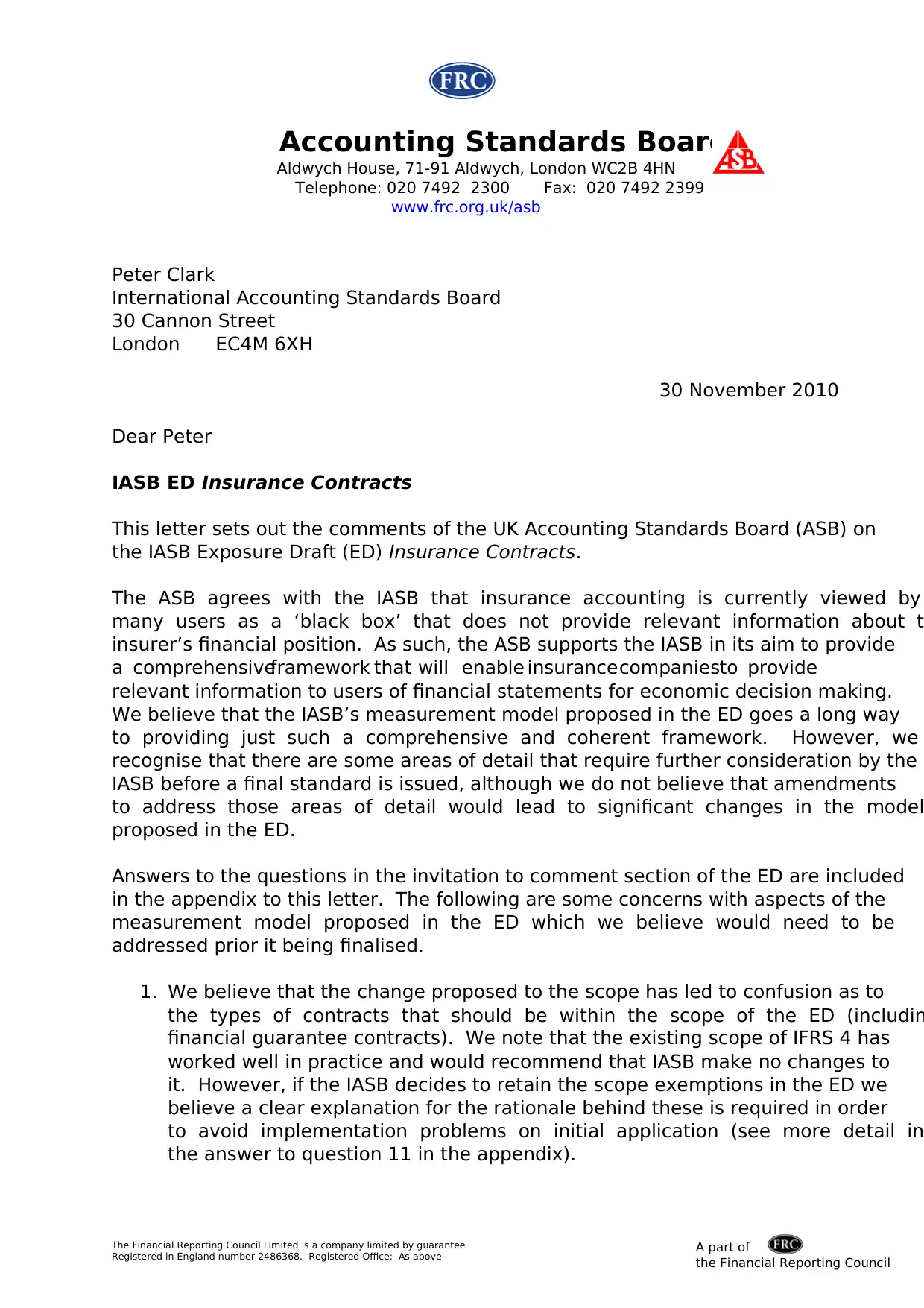
The Financial Reporting Council Limited is a company limited by guarantee
Registered in England number 2486368. Registered Office: As above A part of
the Financial Reporting Council
Accounting Standards Board
Aldwych House, 71-91 Aldwych, London WC2B 4HN
Telephone: 020 7492 2300 Fax: 020 7492 2399
www.frc.org.uk/asb
Peter Clark
International Accounting Standards Board
30 Cannon Street
London EC4M 6XH
30 November 2010
Dear Peter
IASB ED Insurance Contracts
This letter sets out the comments of the UK Accounting Standards Board (ASB) on
the IASB Exposure Draft (ED) Insurance Contracts.
The ASB agrees with the IASB that insurance accounting is currently viewed by
many users as a ‘black box’ that does not provide relevant information about t
insurer’s financial position. As such, the ASB supports the IASB in its aim to provide
a comprehensiveframework that will enable insurance companiesto provide
relevant information to users of financial statements for economic decision making.
We believe that the IASB’s measurement model proposed in the ED goes a long way
to providing just such a comprehensive and coherent framework. However, we
recognise that there are some areas of detail that require further consideration by the
IASB before a final standard is issued, although we do not believe that amendments
to address those areas of detail would lead to significant changes in the model
proposed in the ED.
Answers to the questions in the invitation to comment section of the ED are included
in the appendix to this letter. The following are some concerns with aspects of the
measurement model proposed in the ED which we believe would need to be
addressed prior it being finalised.
1. We believe that the change proposed to the scope has led to confusion as to
the types of contracts that should be within the scope of the ED (includin
financial guarantee contracts). We note that the existing scope of IFRS 4 has
worked well in practice and would recommend that IASB make no changes to
it. However, if the IASB decides to retain the scope exemptions in the ED we
believe a clear explanation for the rationale behind these is required in order
to avoid implementation problems on initial application (see more detail in
the answer to question 11 in the appendix).
Registered in England number 2486368. Registered Office: As above A part of
the Financial Reporting Council
Accounting Standards Board
Aldwych House, 71-91 Aldwych, London WC2B 4HN
Telephone: 020 7492 2300 Fax: 020 7492 2399
www.frc.org.uk/asb
Peter Clark
International Accounting Standards Board
30 Cannon Street
London EC4M 6XH
30 November 2010
Dear Peter
IASB ED Insurance Contracts
This letter sets out the comments of the UK Accounting Standards Board (ASB) on
the IASB Exposure Draft (ED) Insurance Contracts.
The ASB agrees with the IASB that insurance accounting is currently viewed by
many users as a ‘black box’ that does not provide relevant information about t
insurer’s financial position. As such, the ASB supports the IASB in its aim to provide
a comprehensiveframework that will enable insurance companiesto provide
relevant information to users of financial statements for economic decision making.
We believe that the IASB’s measurement model proposed in the ED goes a long way
to providing just such a comprehensive and coherent framework. However, we
recognise that there are some areas of detail that require further consideration by the
IASB before a final standard is issued, although we do not believe that amendments
to address those areas of detail would lead to significant changes in the model
proposed in the ED.
Answers to the questions in the invitation to comment section of the ED are included
in the appendix to this letter. The following are some concerns with aspects of the
measurement model proposed in the ED which we believe would need to be
addressed prior it being finalised.
1. We believe that the change proposed to the scope has led to confusion as to
the types of contracts that should be within the scope of the ED (includin
financial guarantee contracts). We note that the existing scope of IFRS 4 has
worked well in practice and would recommend that IASB make no changes to
it. However, if the IASB decides to retain the scope exemptions in the ED we
believe a clear explanation for the rationale behind these is required in order
to avoid implementation problems on initial application (see more detail in
the answer to question 11 in the appendix).
Paraphrase This Document
Need a fresh take? Get an instant paraphrase of this document with our AI Paraphraser

ASB Response to IASB ED Insurance Contracts
Page 2 of 17
2. We suggest that the use of the modified measurement approach for short-
duration contractsis permitted but not required. We believe that the
modification itself is a concession for entities with short-duration contracts
and that it should be up to the entities to decide whether it is appropriate for
them to take up the concession. As such, to assist users in their
understanding of the information included in the financial statements the
disclosure requirements in the final standard should set out a requirement for
entities to provide information on their rationale for adopting that model.
3. The ED prohibits insurers from presenting volume information on the face of
the financial statements. The ASB understands that users are particularly
concerned about the loss of volume information from the face of the insurer’s
income statement. They are concerned that the presentation approach in the
standard would deprive them of vital information about the business
undertaken by the insurer during the period. The ASB believes that more
work is required to ensure that the requirements in the final standard alla
users’ concerns in this area. We believe that the best way in which this
information can be presented in the financial statements, without making
them cluttered, should be considered during the field testing of this standard.
(see point 5 below).
4. We also draw you attention to the issues in relation to transition adjustments
and the effective date for the final standard. Given the many regulatory and
accounting changes faced by the insurance industry we would recommend
that the IASB work closely with the insurance industry and users to ensure
that a cost effective and smooth transition to the measurement model is
achieved. In this respect, we would draw your attention in particular to the
treatment of the residual margin in the insurer’s extant portfolio on transition
to the new standard, which will lead to the entire deferred profits in those
portfolios being transferred to retained earnings. We believe this approach to
transition disregards the long term nature of certain insurance contracts and
will lead to future profits on those not being recognised. We would
recommend that the IASB consider permitting other approaches to transition
5. We understand that the IASB is currently conducting some field testing in
relation to the application of the requirementsin the ED. We would
recommend that the IASB considers the scope and sufficiency of such field
testing to ensures that it deals with a wide range of business types and sizes.
Page 2 of 17
2. We suggest that the use of the modified measurement approach for short-
duration contractsis permitted but not required. We believe that the
modification itself is a concession for entities with short-duration contracts
and that it should be up to the entities to decide whether it is appropriate for
them to take up the concession. As such, to assist users in their
understanding of the information included in the financial statements the
disclosure requirements in the final standard should set out a requirement for
entities to provide information on their rationale for adopting that model.
3. The ED prohibits insurers from presenting volume information on the face of
the financial statements. The ASB understands that users are particularly
concerned about the loss of volume information from the face of the insurer’s
income statement. They are concerned that the presentation approach in the
standard would deprive them of vital information about the business
undertaken by the insurer during the period. The ASB believes that more
work is required to ensure that the requirements in the final standard alla
users’ concerns in this area. We believe that the best way in which this
information can be presented in the financial statements, without making
them cluttered, should be considered during the field testing of this standard.
(see point 5 below).
4. We also draw you attention to the issues in relation to transition adjustments
and the effective date for the final standard. Given the many regulatory and
accounting changes faced by the insurance industry we would recommend
that the IASB work closely with the insurance industry and users to ensure
that a cost effective and smooth transition to the measurement model is
achieved. In this respect, we would draw your attention in particular to the
treatment of the residual margin in the insurer’s extant portfolio on transition
to the new standard, which will lead to the entire deferred profits in those
portfolios being transferred to retained earnings. We believe this approach to
transition disregards the long term nature of certain insurance contracts and
will lead to future profits on those not being recognised. We would
recommend that the IASB consider permitting other approaches to transition
5. We understand that the IASB is currently conducting some field testing in
relation to the application of the requirementsin the ED. We would
recommend that the IASB considers the scope and sufficiency of such field
testing to ensures that it deals with a wide range of business types and sizes.
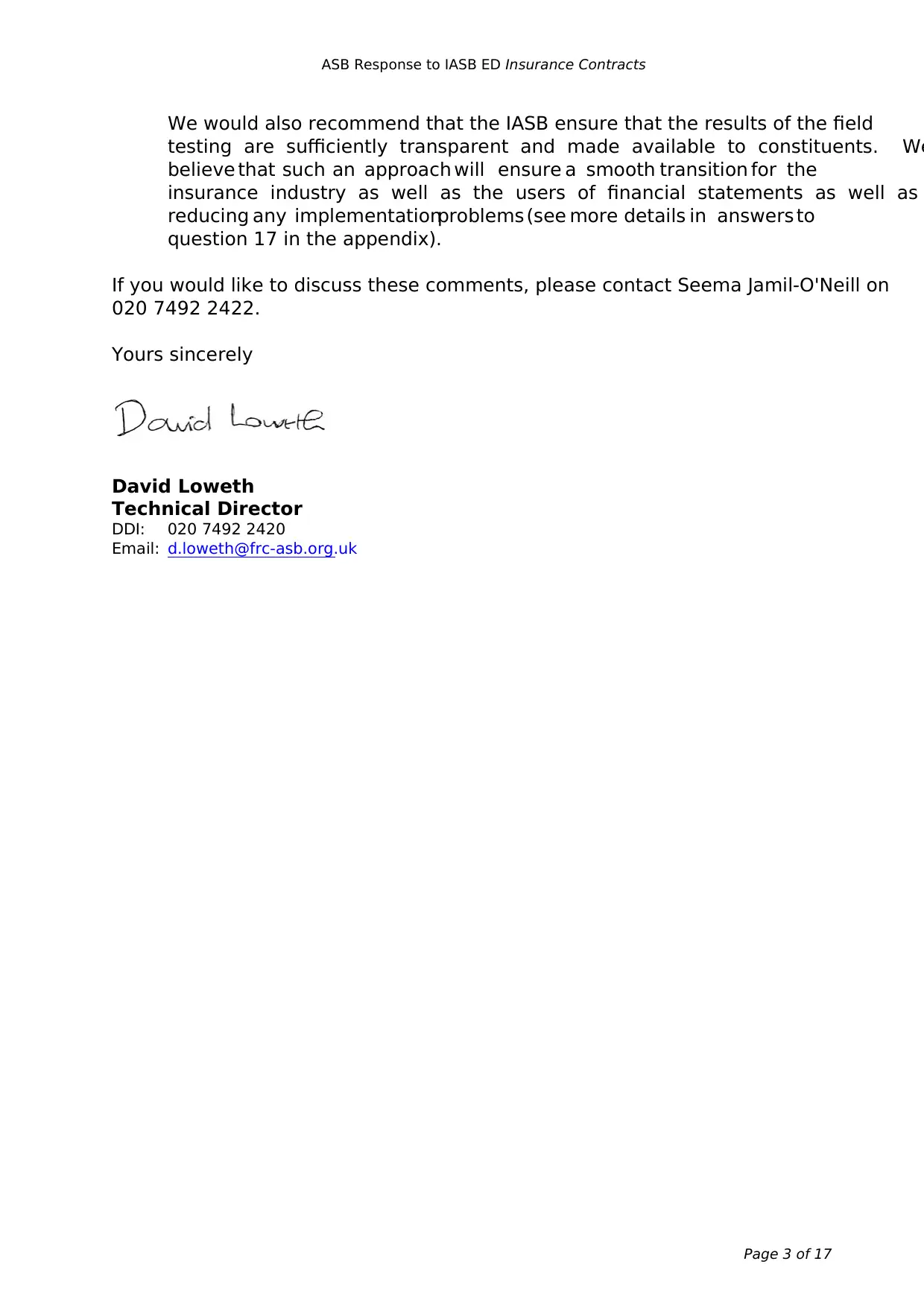
ASB Response to IASB ED Insurance Contracts
Page 3 of 17
We would also recommend that the IASB ensure that the results of the field
testing are sufficiently transparent and made available to constituents. We
believe that such an approach will ensure a smooth transition for the
insurance industry as well as the users of financial statements as well as
reducing any implementationproblems (see more details in answers to
question 17 in the appendix).
If you would like to discuss these comments, please contact Seema Jamil-O'Neill on
020 7492 2422.
Yours sincerely
David Loweth
Technical Director
DDI: 020 7492 2420
Email: d.loweth@frc-asb.org.uk
Page 3 of 17
We would also recommend that the IASB ensure that the results of the field
testing are sufficiently transparent and made available to constituents. We
believe that such an approach will ensure a smooth transition for the
insurance industry as well as the users of financial statements as well as
reducing any implementationproblems (see more details in answers to
question 17 in the appendix).
If you would like to discuss these comments, please contact Seema Jamil-O'Neill on
020 7492 2422.
Yours sincerely
David Loweth
Technical Director
DDI: 020 7492 2420
Email: d.loweth@frc-asb.org.uk
⊘ This is a preview!⊘
Do you want full access?
Subscribe today to unlock all pages.

Trusted by 1+ million students worldwide

ASB Response to IASB ED Insurance Contracts
Page 4 of 17
Appendix: Responses to questions in the IASB ED Insurance Contr
Measurement
Question 1 – Relevant information for users (paragraphs BC13–BC50)
Do you think that the proposed measurement model will produce relevant information t
will help users of an insurer’s financial statements to make economic decisions? Why o
not? If not, what changes do you recommend and why?
ASB response:
1. The ASB agrees that the proposals in the ED represent an improvement in
financial reporting of insurance contracts. In particular, we believe that th
accounting and measurement proposals in the ED which provide similar
treatment for life and non-life contracts will enhance the understandability
and consistencyof insurer's financial statements. We believe the ED’s
proposals make it easier for users to understandthe insurer’s financial
position in the context of its business model and to compare it to those o
other insurers.
2. We also believe that the inclusion of the explicit margins from the insurance
contracts on the face of the statement of financial position will ensure tha
users have access to full information about the insurance entity’s profitability.
Although, we note there are concerns in relation to the appropriate disclosure
of volume information that would need to be addressed before the IASB can
finalise the standard. For more detail see our answer to question 13.
3. We also note that there are areas of detail where further consideration is
required before the proposals can be issued as the final standard. We discuss
some of these areas of detail together with some proposed solutions in th
answers to the following questions.
Question 2 – Fulfilment cash flows (paragraphs 17(a), 22–25, B37–B66 and BC
(a) Do you agree that the measurement of an insurance contract should inclu
expected present value of the future cash outflows less future cash inflows that w
arise as the insurer fulfils the insurance contract? Why or why not? If not, what do
you recommend and why?
(b) Is the draft application guidance in Appendix B on estimates of future cash flows
the right level of detail? Do you have any comments on the guidance?
ASB response:
4. The ASB agrees with the IASB that measurement of an insurance contract
should include the expected present value of the future cash flows that will
arise as the insurer fulfils the insurance contract. We also agree that the
portfolio is the appropriate level of measurement for insurance contracts.
Page 4 of 17
Appendix: Responses to questions in the IASB ED Insurance Contr
Measurement
Question 1 – Relevant information for users (paragraphs BC13–BC50)
Do you think that the proposed measurement model will produce relevant information t
will help users of an insurer’s financial statements to make economic decisions? Why o
not? If not, what changes do you recommend and why?
ASB response:
1. The ASB agrees that the proposals in the ED represent an improvement in
financial reporting of insurance contracts. In particular, we believe that th
accounting and measurement proposals in the ED which provide similar
treatment for life and non-life contracts will enhance the understandability
and consistencyof insurer's financial statements. We believe the ED’s
proposals make it easier for users to understandthe insurer’s financial
position in the context of its business model and to compare it to those o
other insurers.
2. We also believe that the inclusion of the explicit margins from the insurance
contracts on the face of the statement of financial position will ensure tha
users have access to full information about the insurance entity’s profitability.
Although, we note there are concerns in relation to the appropriate disclosure
of volume information that would need to be addressed before the IASB can
finalise the standard. For more detail see our answer to question 13.
3. We also note that there are areas of detail where further consideration is
required before the proposals can be issued as the final standard. We discuss
some of these areas of detail together with some proposed solutions in th
answers to the following questions.
Question 2 – Fulfilment cash flows (paragraphs 17(a), 22–25, B37–B66 and BC
(a) Do you agree that the measurement of an insurance contract should inclu
expected present value of the future cash outflows less future cash inflows that w
arise as the insurer fulfils the insurance contract? Why or why not? If not, what do
you recommend and why?
(b) Is the draft application guidance in Appendix B on estimates of future cash flows
the right level of detail? Do you have any comments on the guidance?
ASB response:
4. The ASB agrees with the IASB that measurement of an insurance contract
should include the expected present value of the future cash flows that will
arise as the insurer fulfils the insurance contract. We also agree that the
portfolio is the appropriate level of measurement for insurance contracts.
Paraphrase This Document
Need a fresh take? Get an instant paraphrase of this document with our AI Paraphraser
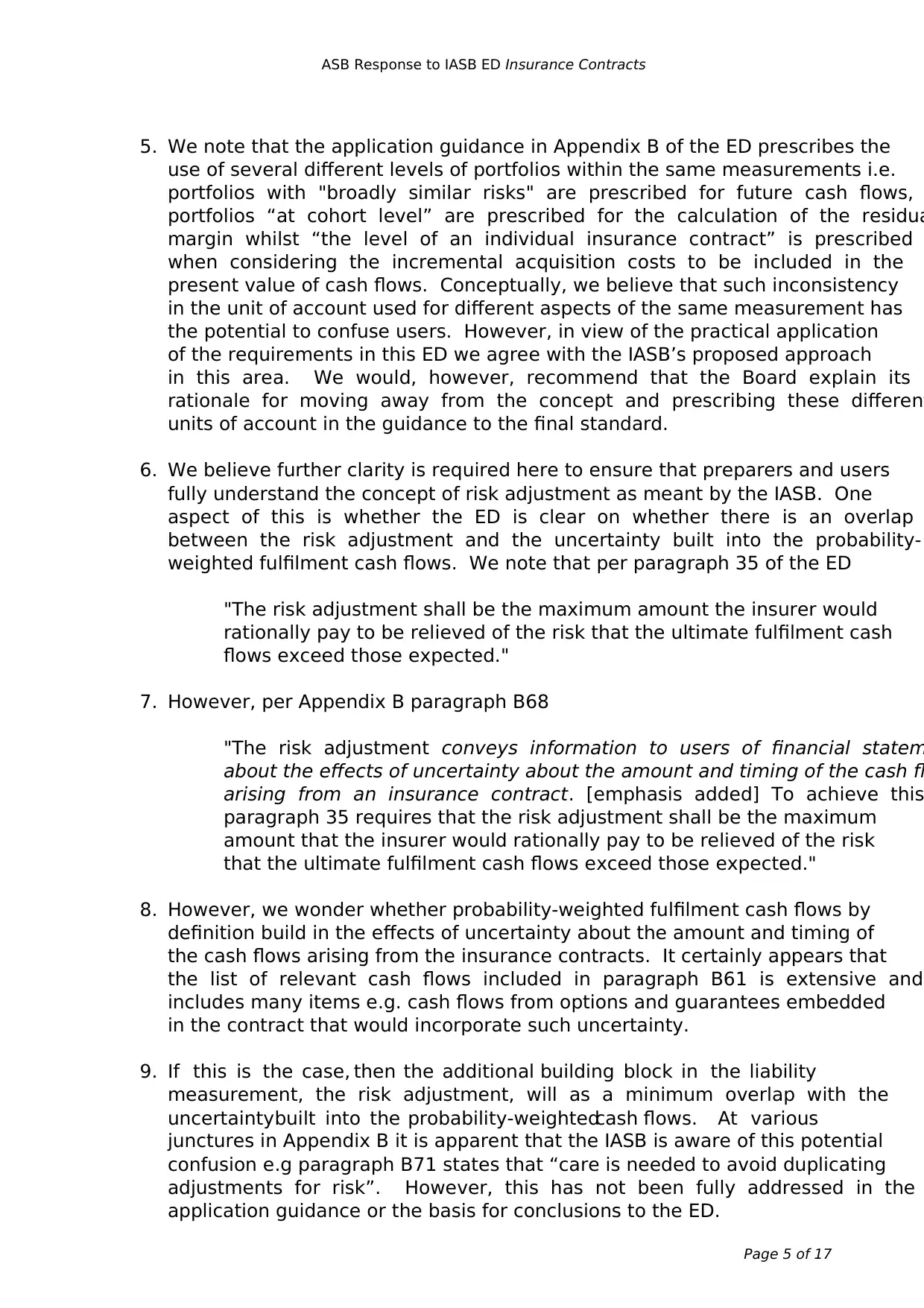
ASB Response to IASB ED Insurance Contracts
Page 5 of 17
5. We note that the application guidance in Appendix B of the ED prescribes the
use of several different levels of portfolios within the same measurements i.e.
portfolios with "broadly similar risks" are prescribed for future cash flows,
portfolios “at cohort level” are prescribed for the calculation of the residua
margin whilst “the level of an individual insurance contract” is prescribed
when considering the incremental acquisition costs to be included in the
present value of cash flows. Conceptually, we believe that such inconsistency
in the unit of account used for different aspects of the same measurement has
the potential to confuse users. However, in view of the practical application
of the requirements in this ED we agree with the IASB’s proposed approach
in this area. We would, however, recommend that the Board explain its
rationale for moving away from the concept and prescribing these different
units of account in the guidance to the final standard.
6. We believe further clarity is required here to ensure that preparers and users
fully understand the concept of risk adjustment as meant by the IASB. One
aspect of this is whether the ED is clear on whether there is an overlap
between the risk adjustment and the uncertainty built into the probability-
weighted fulfilment cash flows. We note that per paragraph 35 of the ED
"The risk adjustment shall be the maximum amount the insurer would
rationally pay to be relieved of the risk that the ultimate fulfilment cash
flows exceed those expected."
7. However, per Appendix B paragraph B68
"The risk adjustment conveys information to users of financial statem
about the effects of uncertainty about the amount and timing of the cash fl
arising from an insurance contract. [emphasis added] To achieve this
paragraph 35 requires that the risk adjustment shall be the maximum
amount that the insurer would rationally pay to be relieved of the risk
that the ultimate fulfilment cash flows exceed those expected."
8. However, we wonder whether probability-weighted fulfilment cash flows by
definition build in the effects of uncertainty about the amount and timing of
the cash flows arising from the insurance contracts. It certainly appears that
the list of relevant cash flows included in paragraph B61 is extensive and
includes many items e.g. cash flows from options and guarantees embedded
in the contract that would incorporate such uncertainty.
9. If this is the case, then the additional building block in the liability
measurement, the risk adjustment, will as a minimum overlap with the
uncertaintybuilt into the probability-weightedcash flows. At various
junctures in Appendix B it is apparent that the IASB is aware of this potential
confusion e.g paragraph B71 states that “care is needed to avoid duplicating
adjustments for risk”. However, this has not been fully addressed in the
application guidance or the basis for conclusions to the ED.
Page 5 of 17
5. We note that the application guidance in Appendix B of the ED prescribes the
use of several different levels of portfolios within the same measurements i.e.
portfolios with "broadly similar risks" are prescribed for future cash flows,
portfolios “at cohort level” are prescribed for the calculation of the residua
margin whilst “the level of an individual insurance contract” is prescribed
when considering the incremental acquisition costs to be included in the
present value of cash flows. Conceptually, we believe that such inconsistency
in the unit of account used for different aspects of the same measurement has
the potential to confuse users. However, in view of the practical application
of the requirements in this ED we agree with the IASB’s proposed approach
in this area. We would, however, recommend that the Board explain its
rationale for moving away from the concept and prescribing these different
units of account in the guidance to the final standard.
6. We believe further clarity is required here to ensure that preparers and users
fully understand the concept of risk adjustment as meant by the IASB. One
aspect of this is whether the ED is clear on whether there is an overlap
between the risk adjustment and the uncertainty built into the probability-
weighted fulfilment cash flows. We note that per paragraph 35 of the ED
"The risk adjustment shall be the maximum amount the insurer would
rationally pay to be relieved of the risk that the ultimate fulfilment cash
flows exceed those expected."
7. However, per Appendix B paragraph B68
"The risk adjustment conveys information to users of financial statem
about the effects of uncertainty about the amount and timing of the cash fl
arising from an insurance contract. [emphasis added] To achieve this
paragraph 35 requires that the risk adjustment shall be the maximum
amount that the insurer would rationally pay to be relieved of the risk
that the ultimate fulfilment cash flows exceed those expected."
8. However, we wonder whether probability-weighted fulfilment cash flows by
definition build in the effects of uncertainty about the amount and timing of
the cash flows arising from the insurance contracts. It certainly appears that
the list of relevant cash flows included in paragraph B61 is extensive and
includes many items e.g. cash flows from options and guarantees embedded
in the contract that would incorporate such uncertainty.
9. If this is the case, then the additional building block in the liability
measurement, the risk adjustment, will as a minimum overlap with the
uncertaintybuilt into the probability-weightedcash flows. At various
junctures in Appendix B it is apparent that the IASB is aware of this potential
confusion e.g paragraph B71 states that “care is needed to avoid duplicating
adjustments for risk”. However, this has not been fully addressed in the
application guidance or the basis for conclusions to the ED.
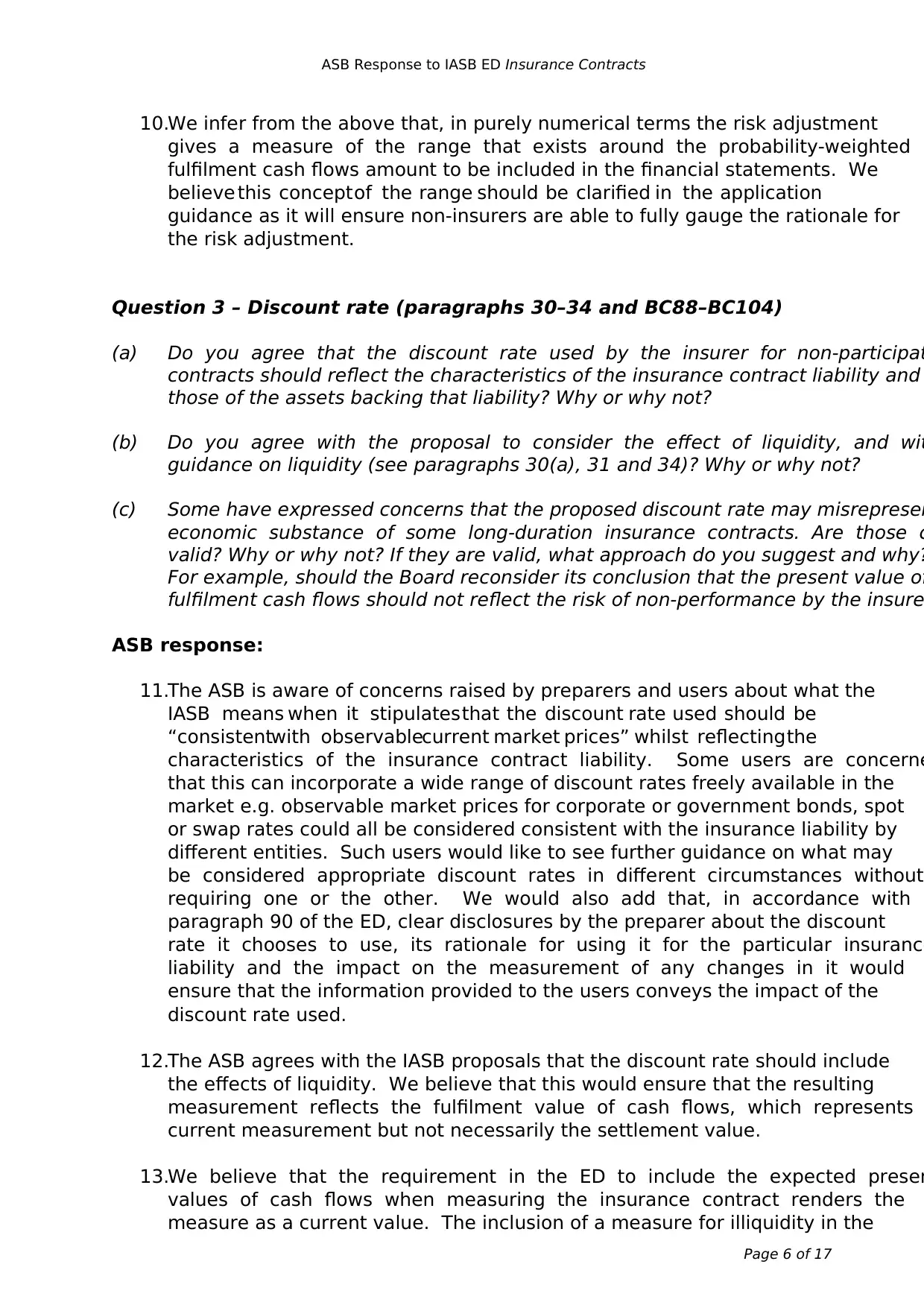
ASB Response to IASB ED Insurance Contracts
Page 6 of 17
10.We infer from the above that, in purely numerical terms the risk adjustment
gives a measure of the range that exists around the probability-weighted
fulfilment cash flows amount to be included in the financial statements. We
believe this concept of the range should be clarified in the application
guidance as it will ensure non-insurers are able to fully gauge the rationale for
the risk adjustment.
Question 3 – Discount rate (paragraphs 30–34 and BC88–BC104)
(a) Do you agree that the discount rate used by the insurer for non-participat
contracts should reflect the characteristics of the insurance contract liability and
those of the assets backing that liability? Why or why not?
(b) Do you agree with the proposal to consider the effect of liquidity, and wit
guidance on liquidity (see paragraphs 30(a), 31 and 34)? Why or why not?
(c) Some have expressed concerns that the proposed discount rate may misrepresen
economic substance of some long-duration insurance contracts. Are those c
valid? Why or why not? If they are valid, what approach do you suggest and why?
For example, should the Board reconsider its conclusion that the present value of
fulfilment cash flows should not reflect the risk of non-performance by the insure
ASB response:
11.The ASB is aware of concerns raised by preparers and users about what the
IASB means when it stipulates that the discount rate used should be
“consistentwith observablecurrent market prices” whilst reflecting the
characteristics of the insurance contract liability. Some users are concerne
that this can incorporate a wide range of discount rates freely available in the
market e.g. observable market prices for corporate or government bonds, spot
or swap rates could all be considered consistent with the insurance liability by
different entities. Such users would like to see further guidance on what may
be considered appropriate discount rates in different circumstances without
requiring one or the other. We would also add that, in accordance with
paragraph 90 of the ED, clear disclosures by the preparer about the discount
rate it chooses to use, its rationale for using it for the particular insurance
liability and the impact on the measurement of any changes in it would
ensure that the information provided to the users conveys the impact of the
discount rate used.
12.The ASB agrees with the IASB proposals that the discount rate should include
the effects of liquidity. We believe that this would ensure that the resulting
measurement reflects the fulfilment value of cash flows, which represents
current measurement but not necessarily the settlement value.
13.We believe that the requirement in the ED to include the expected presen
values of cash flows when measuring the insurance contract renders the
measure as a current value. The inclusion of a measure for illiquidity in the
Page 6 of 17
10.We infer from the above that, in purely numerical terms the risk adjustment
gives a measure of the range that exists around the probability-weighted
fulfilment cash flows amount to be included in the financial statements. We
believe this concept of the range should be clarified in the application
guidance as it will ensure non-insurers are able to fully gauge the rationale for
the risk adjustment.
Question 3 – Discount rate (paragraphs 30–34 and BC88–BC104)
(a) Do you agree that the discount rate used by the insurer for non-participat
contracts should reflect the characteristics of the insurance contract liability and
those of the assets backing that liability? Why or why not?
(b) Do you agree with the proposal to consider the effect of liquidity, and wit
guidance on liquidity (see paragraphs 30(a), 31 and 34)? Why or why not?
(c) Some have expressed concerns that the proposed discount rate may misrepresen
economic substance of some long-duration insurance contracts. Are those c
valid? Why or why not? If they are valid, what approach do you suggest and why?
For example, should the Board reconsider its conclusion that the present value of
fulfilment cash flows should not reflect the risk of non-performance by the insure
ASB response:
11.The ASB is aware of concerns raised by preparers and users about what the
IASB means when it stipulates that the discount rate used should be
“consistentwith observablecurrent market prices” whilst reflecting the
characteristics of the insurance contract liability. Some users are concerne
that this can incorporate a wide range of discount rates freely available in the
market e.g. observable market prices for corporate or government bonds, spot
or swap rates could all be considered consistent with the insurance liability by
different entities. Such users would like to see further guidance on what may
be considered appropriate discount rates in different circumstances without
requiring one or the other. We would also add that, in accordance with
paragraph 90 of the ED, clear disclosures by the preparer about the discount
rate it chooses to use, its rationale for using it for the particular insurance
liability and the impact on the measurement of any changes in it would
ensure that the information provided to the users conveys the impact of the
discount rate used.
12.The ASB agrees with the IASB proposals that the discount rate should include
the effects of liquidity. We believe that this would ensure that the resulting
measurement reflects the fulfilment value of cash flows, which represents
current measurement but not necessarily the settlement value.
13.We believe that the requirement in the ED to include the expected presen
values of cash flows when measuring the insurance contract renders the
measure as a current value. The inclusion of a measure for illiquidity in the
⊘ This is a preview!⊘
Do you want full access?
Subscribe today to unlock all pages.

Trusted by 1+ million students worldwide
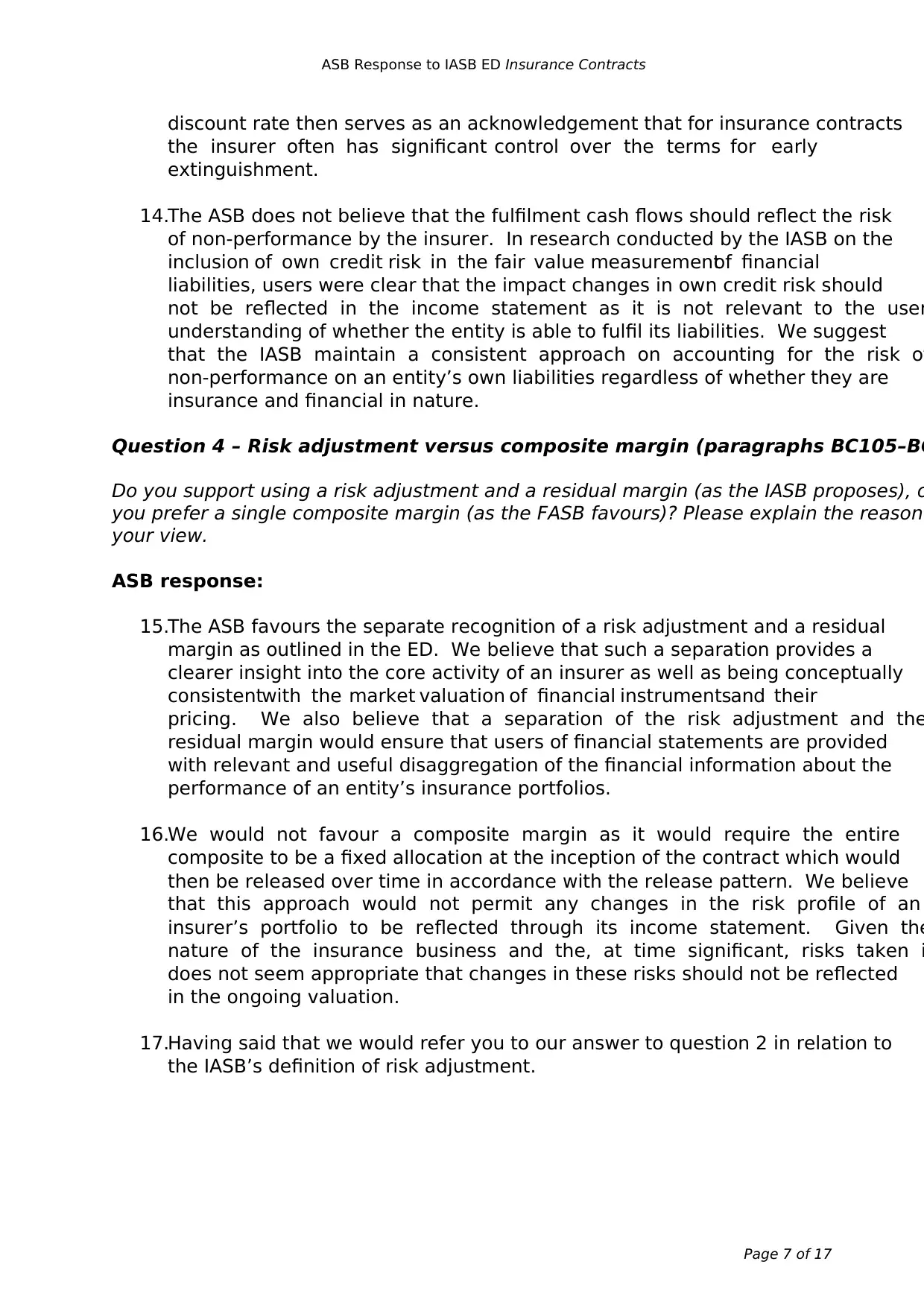
ASB Response to IASB ED Insurance Contracts
Page 7 of 17
discount rate then serves as an acknowledgement that for insurance contracts
the insurer often has significant control over the terms for early
extinguishment.
14.The ASB does not believe that the fulfilment cash flows should reflect the risk
of non-performance by the insurer. In research conducted by the IASB on the
inclusion of own credit risk in the fair value measurementof financial
liabilities, users were clear that the impact changes in own credit risk should
not be reflected in the income statement as it is not relevant to the user
understanding of whether the entity is able to fulfil its liabilities. We suggest
that the IASB maintain a consistent approach on accounting for the risk of
non-performance on an entity’s own liabilities regardless of whether they are
insurance and financial in nature.
Question 4 – Risk adjustment versus composite margin (paragraphs BC105–BC
Do you support using a risk adjustment and a residual margin (as the IASB proposes), o
you prefer a single composite margin (as the FASB favours)? Please explain the reason(
your view.
ASB response:
15.The ASB favours the separate recognition of a risk adjustment and a residual
margin as outlined in the ED. We believe that such a separation provides a
clearer insight into the core activity of an insurer as well as being conceptually
consistentwith the market valuation of financial instrumentsand their
pricing. We also believe that a separation of the risk adjustment and the
residual margin would ensure that users of financial statements are provided
with relevant and useful disaggregation of the financial information about the
performance of an entity’s insurance portfolios.
16.We would not favour a composite margin as it would require the entire
composite to be a fixed allocation at the inception of the contract which would
then be released over time in accordance with the release pattern. We believe
that this approach would not permit any changes in the risk profile of an
insurer’s portfolio to be reflected through its income statement. Given the
nature of the insurance business and the, at time significant, risks taken i
does not seem appropriate that changes in these risks should not be reflected
in the ongoing valuation.
17.Having said that we would refer you to our answer to question 2 in relation to
the IASB’s definition of risk adjustment.
Page 7 of 17
discount rate then serves as an acknowledgement that for insurance contracts
the insurer often has significant control over the terms for early
extinguishment.
14.The ASB does not believe that the fulfilment cash flows should reflect the risk
of non-performance by the insurer. In research conducted by the IASB on the
inclusion of own credit risk in the fair value measurementof financial
liabilities, users were clear that the impact changes in own credit risk should
not be reflected in the income statement as it is not relevant to the user
understanding of whether the entity is able to fulfil its liabilities. We suggest
that the IASB maintain a consistent approach on accounting for the risk of
non-performance on an entity’s own liabilities regardless of whether they are
insurance and financial in nature.
Question 4 – Risk adjustment versus composite margin (paragraphs BC105–BC
Do you support using a risk adjustment and a residual margin (as the IASB proposes), o
you prefer a single composite margin (as the FASB favours)? Please explain the reason(
your view.
ASB response:
15.The ASB favours the separate recognition of a risk adjustment and a residual
margin as outlined in the ED. We believe that such a separation provides a
clearer insight into the core activity of an insurer as well as being conceptually
consistentwith the market valuation of financial instrumentsand their
pricing. We also believe that a separation of the risk adjustment and the
residual margin would ensure that users of financial statements are provided
with relevant and useful disaggregation of the financial information about the
performance of an entity’s insurance portfolios.
16.We would not favour a composite margin as it would require the entire
composite to be a fixed allocation at the inception of the contract which would
then be released over time in accordance with the release pattern. We believe
that this approach would not permit any changes in the risk profile of an
insurer’s portfolio to be reflected through its income statement. Given the
nature of the insurance business and the, at time significant, risks taken i
does not seem appropriate that changes in these risks should not be reflected
in the ongoing valuation.
17.Having said that we would refer you to our answer to question 2 in relation to
the IASB’s definition of risk adjustment.
Paraphrase This Document
Need a fresh take? Get an instant paraphrase of this document with our AI Paraphraser
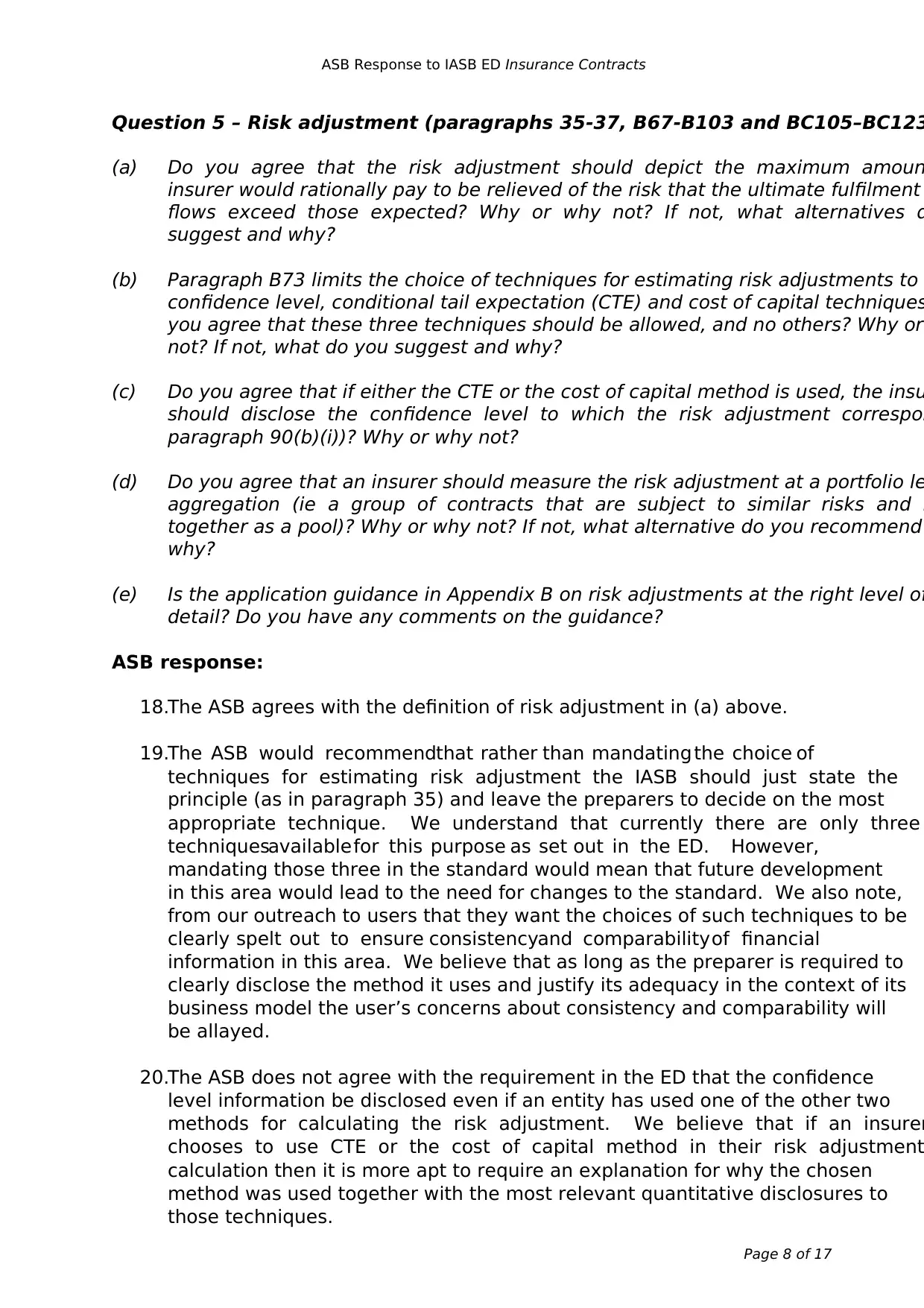
ASB Response to IASB ED Insurance Contracts
Page 8 of 17
Question 5 – Risk adjustment (paragraphs 35-37, B67-B103 and BC105–BC123
(a) Do you agree that the risk adjustment should depict the maximum amoun
insurer would rationally pay to be relieved of the risk that the ultimate fulfilment
flows exceed those expected? Why or why not? If not, what alternatives d
suggest and why?
(b) Paragraph B73 limits the choice of techniques for estimating risk adjustments to
confidence level, conditional tail expectation (CTE) and cost of capital techniques
you agree that these three techniques should be allowed, and no others? Why or
not? If not, what do you suggest and why?
(c) Do you agree that if either the CTE or the cost of capital method is used, the insu
should disclose the confidence level to which the risk adjustment correspon
paragraph 90(b)(i))? Why or why not?
(d) Do you agree that an insurer should measure the risk adjustment at a portfolio le
aggregation (ie a group of contracts that are subject to similar risks and m
together as a pool)? Why or why not? If not, what alternative do you recommend
why?
(e) Is the application guidance in Appendix B on risk adjustments at the right level of
detail? Do you have any comments on the guidance?
ASB response:
18.The ASB agrees with the definition of risk adjustment in (a) above.
19.The ASB would recommendthat rather than mandating the choice of
techniques for estimating risk adjustment the IASB should just state the
principle (as in paragraph 35) and leave the preparers to decide on the most
appropriate technique. We understand that currently there are only three
techniquesavailable for this purpose as set out in the ED. However,
mandating those three in the standard would mean that future development
in this area would lead to the need for changes to the standard. We also note,
from our outreach to users that they want the choices of such techniques to be
clearly spelt out to ensure consistencyand comparability of financial
information in this area. We believe that as long as the preparer is required to
clearly disclose the method it uses and justify its adequacy in the context of its
business model the user’s concerns about consistency and comparability will
be allayed.
20.The ASB does not agree with the requirement in the ED that the confidence
level information be disclosed even if an entity has used one of the other two
methods for calculating the risk adjustment. We believe that if an insurer
chooses to use CTE or the cost of capital method in their risk adjustment
calculation then it is more apt to require an explanation for why the chosen
method was used together with the most relevant quantitative disclosures to
those techniques.
Page 8 of 17
Question 5 – Risk adjustment (paragraphs 35-37, B67-B103 and BC105–BC123
(a) Do you agree that the risk adjustment should depict the maximum amoun
insurer would rationally pay to be relieved of the risk that the ultimate fulfilment
flows exceed those expected? Why or why not? If not, what alternatives d
suggest and why?
(b) Paragraph B73 limits the choice of techniques for estimating risk adjustments to
confidence level, conditional tail expectation (CTE) and cost of capital techniques
you agree that these three techniques should be allowed, and no others? Why or
not? If not, what do you suggest and why?
(c) Do you agree that if either the CTE or the cost of capital method is used, the insu
should disclose the confidence level to which the risk adjustment correspon
paragraph 90(b)(i))? Why or why not?
(d) Do you agree that an insurer should measure the risk adjustment at a portfolio le
aggregation (ie a group of contracts that are subject to similar risks and m
together as a pool)? Why or why not? If not, what alternative do you recommend
why?
(e) Is the application guidance in Appendix B on risk adjustments at the right level of
detail? Do you have any comments on the guidance?
ASB response:
18.The ASB agrees with the definition of risk adjustment in (a) above.
19.The ASB would recommendthat rather than mandating the choice of
techniques for estimating risk adjustment the IASB should just state the
principle (as in paragraph 35) and leave the preparers to decide on the most
appropriate technique. We understand that currently there are only three
techniquesavailable for this purpose as set out in the ED. However,
mandating those three in the standard would mean that future development
in this area would lead to the need for changes to the standard. We also note,
from our outreach to users that they want the choices of such techniques to be
clearly spelt out to ensure consistencyand comparability of financial
information in this area. We believe that as long as the preparer is required to
clearly disclose the method it uses and justify its adequacy in the context of its
business model the user’s concerns about consistency and comparability will
be allayed.
20.The ASB does not agree with the requirement in the ED that the confidence
level information be disclosed even if an entity has used one of the other two
methods for calculating the risk adjustment. We believe that if an insurer
chooses to use CTE or the cost of capital method in their risk adjustment
calculation then it is more apt to require an explanation for why the chosen
method was used together with the most relevant quantitative disclosures to
those techniques.
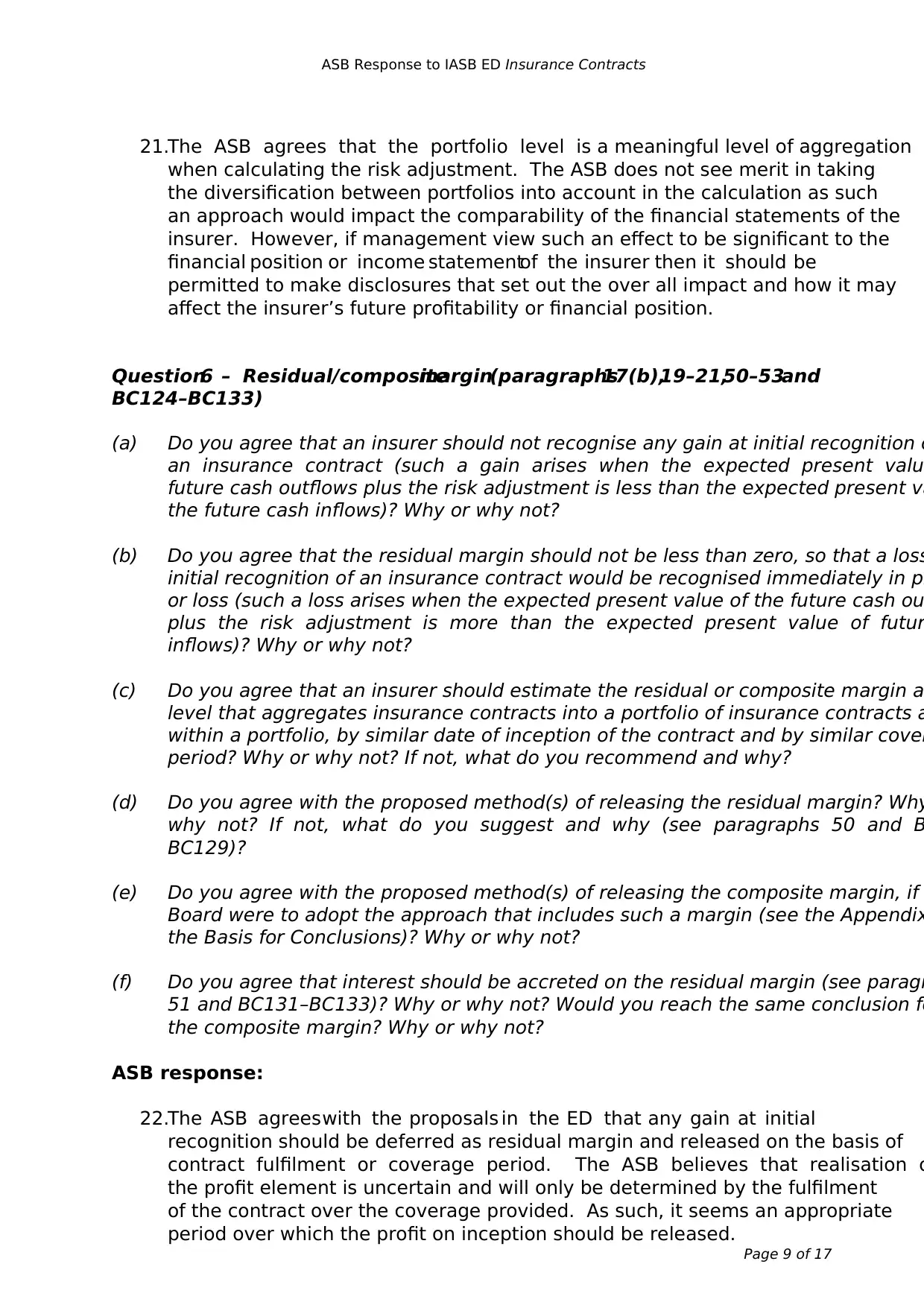
ASB Response to IASB ED Insurance Contracts
Page 9 of 17
21.The ASB agrees that the portfolio level is a meaningful level of aggregation
when calculating the risk adjustment. The ASB does not see merit in taking
the diversification between portfolios into account in the calculation as such
an approach would impact the comparability of the financial statements of the
insurer. However, if management view such an effect to be significant to the
financial position or income statementof the insurer then it should be
permitted to make disclosures that set out the over all impact and how it may
affect the insurer’s future profitability or financial position.
Question6 – Residual/compositemargin(paragraphs17(b),19–21,50–53and
BC124–BC133)
(a) Do you agree that an insurer should not recognise any gain at initial recognition o
an insurance contract (such a gain arises when the expected present valu
future cash outflows plus the risk adjustment is less than the expected present va
the future cash inflows)? Why or why not?
(b) Do you agree that the residual margin should not be less than zero, so that a loss
initial recognition of an insurance contract would be recognised immediately in pr
or loss (such a loss arises when the expected present value of the future cash ou
plus the risk adjustment is more than the expected present value of futur
inflows)? Why or why not?
(c) Do you agree that an insurer should estimate the residual or composite margin a
level that aggregates insurance contracts into a portfolio of insurance contracts a
within a portfolio, by similar date of inception of the contract and by similar cover
period? Why or why not? If not, what do you recommend and why?
(d) Do you agree with the proposed method(s) of releasing the residual margin? Why
why not? If not, what do you suggest and why (see paragraphs 50 and B
BC129)?
(e) Do you agree with the proposed method(s) of releasing the composite margin, if
Board were to adopt the approach that includes such a margin (see the Appendix
the Basis for Conclusions)? Why or why not?
(f) Do you agree that interest should be accreted on the residual margin (see paragr
51 and BC131–BC133)? Why or why not? Would you reach the same conclusion fo
the composite margin? Why or why not?
ASB response:
22.The ASB agrees with the proposals in the ED that any gain at initial
recognition should be deferred as residual margin and released on the basis of
contract fulfilment or coverage period. The ASB believes that realisation o
the profit element is uncertain and will only be determined by the fulfilment
of the contract over the coverage provided. As such, it seems an appropriate
period over which the profit on inception should be released.
Page 9 of 17
21.The ASB agrees that the portfolio level is a meaningful level of aggregation
when calculating the risk adjustment. The ASB does not see merit in taking
the diversification between portfolios into account in the calculation as such
an approach would impact the comparability of the financial statements of the
insurer. However, if management view such an effect to be significant to the
financial position or income statementof the insurer then it should be
permitted to make disclosures that set out the over all impact and how it may
affect the insurer’s future profitability or financial position.
Question6 – Residual/compositemargin(paragraphs17(b),19–21,50–53and
BC124–BC133)
(a) Do you agree that an insurer should not recognise any gain at initial recognition o
an insurance contract (such a gain arises when the expected present valu
future cash outflows plus the risk adjustment is less than the expected present va
the future cash inflows)? Why or why not?
(b) Do you agree that the residual margin should not be less than zero, so that a loss
initial recognition of an insurance contract would be recognised immediately in pr
or loss (such a loss arises when the expected present value of the future cash ou
plus the risk adjustment is more than the expected present value of futur
inflows)? Why or why not?
(c) Do you agree that an insurer should estimate the residual or composite margin a
level that aggregates insurance contracts into a portfolio of insurance contracts a
within a portfolio, by similar date of inception of the contract and by similar cover
period? Why or why not? If not, what do you recommend and why?
(d) Do you agree with the proposed method(s) of releasing the residual margin? Why
why not? If not, what do you suggest and why (see paragraphs 50 and B
BC129)?
(e) Do you agree with the proposed method(s) of releasing the composite margin, if
Board were to adopt the approach that includes such a margin (see the Appendix
the Basis for Conclusions)? Why or why not?
(f) Do you agree that interest should be accreted on the residual margin (see paragr
51 and BC131–BC133)? Why or why not? Would you reach the same conclusion fo
the composite margin? Why or why not?
ASB response:
22.The ASB agrees with the proposals in the ED that any gain at initial
recognition should be deferred as residual margin and released on the basis of
contract fulfilment or coverage period. The ASB believes that realisation o
the profit element is uncertain and will only be determined by the fulfilment
of the contract over the coverage provided. As such, it seems an appropriate
period over which the profit on inception should be released.
⊘ This is a preview!⊘
Do you want full access?
Subscribe today to unlock all pages.

Trusted by 1+ million students worldwide
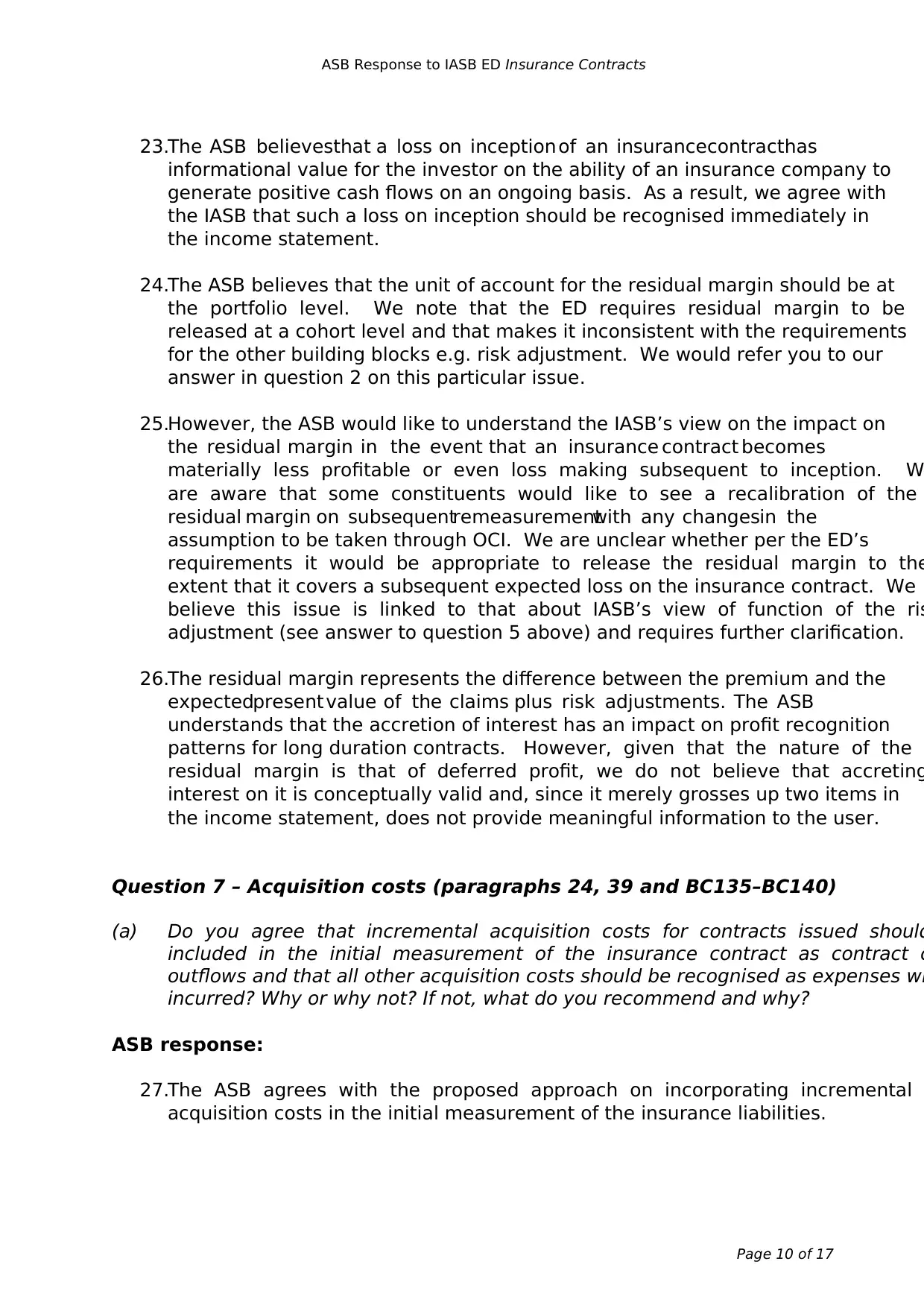
ASB Response to IASB ED Insurance Contracts
Page 10 of 17
23.The ASB believesthat a loss on inception of an insurancecontracthas
informational value for the investor on the ability of an insurance company to
generate positive cash flows on an ongoing basis. As a result, we agree with
the IASB that such a loss on inception should be recognised immediately in
the income statement.
24.The ASB believes that the unit of account for the residual margin should be at
the portfolio level. We note that the ED requires residual margin to be
released at a cohort level and that makes it inconsistent with the requirements
for the other building blocks e.g. risk adjustment. We would refer you to our
answer in question 2 on this particular issue.
25.However, the ASB would like to understand the IASB’s view on the impact on
the residual margin in the event that an insurance contract becomes
materially less profitable or even loss making subsequent to inception. W
are aware that some constituents would like to see a recalibration of the
residual margin on subsequentremeasurementwith any changesin the
assumption to be taken through OCI. We are unclear whether per the ED’s
requirements it would be appropriate to release the residual margin to the
extent that it covers a subsequent expected loss on the insurance contract. We
believe this issue is linked to that about IASB’s view of function of the ris
adjustment (see answer to question 5 above) and requires further clarification.
26.The residual margin represents the difference between the premium and the
expectedpresent value of the claims plus risk adjustments. The ASB
understands that the accretion of interest has an impact on profit recognition
patterns for long duration contracts. However, given that the nature of the
residual margin is that of deferred profit, we do not believe that accreting
interest on it is conceptually valid and, since it merely grosses up two items in
the income statement, does not provide meaningful information to the user.
Question 7 – Acquisition costs (paragraphs 24, 39 and BC135–BC140)
(a) Do you agree that incremental acquisition costs for contracts issued should
included in the initial measurement of the insurance contract as contract c
outflows and that all other acquisition costs should be recognised as expenses wh
incurred? Why or why not? If not, what do you recommend and why?
ASB response:
27.The ASB agrees with the proposed approach on incorporating incremental
acquisition costs in the initial measurement of the insurance liabilities.
Page 10 of 17
23.The ASB believesthat a loss on inception of an insurancecontracthas
informational value for the investor on the ability of an insurance company to
generate positive cash flows on an ongoing basis. As a result, we agree with
the IASB that such a loss on inception should be recognised immediately in
the income statement.
24.The ASB believes that the unit of account for the residual margin should be at
the portfolio level. We note that the ED requires residual margin to be
released at a cohort level and that makes it inconsistent with the requirements
for the other building blocks e.g. risk adjustment. We would refer you to our
answer in question 2 on this particular issue.
25.However, the ASB would like to understand the IASB’s view on the impact on
the residual margin in the event that an insurance contract becomes
materially less profitable or even loss making subsequent to inception. W
are aware that some constituents would like to see a recalibration of the
residual margin on subsequentremeasurementwith any changesin the
assumption to be taken through OCI. We are unclear whether per the ED’s
requirements it would be appropriate to release the residual margin to the
extent that it covers a subsequent expected loss on the insurance contract. We
believe this issue is linked to that about IASB’s view of function of the ris
adjustment (see answer to question 5 above) and requires further clarification.
26.The residual margin represents the difference between the premium and the
expectedpresent value of the claims plus risk adjustments. The ASB
understands that the accretion of interest has an impact on profit recognition
patterns for long duration contracts. However, given that the nature of the
residual margin is that of deferred profit, we do not believe that accreting
interest on it is conceptually valid and, since it merely grosses up two items in
the income statement, does not provide meaningful information to the user.
Question 7 – Acquisition costs (paragraphs 24, 39 and BC135–BC140)
(a) Do you agree that incremental acquisition costs for contracts issued should
included in the initial measurement of the insurance contract as contract c
outflows and that all other acquisition costs should be recognised as expenses wh
incurred? Why or why not? If not, what do you recommend and why?
ASB response:
27.The ASB agrees with the proposed approach on incorporating incremental
acquisition costs in the initial measurement of the insurance liabilities.
Paraphrase This Document
Need a fresh take? Get an instant paraphrase of this document with our AI Paraphraser
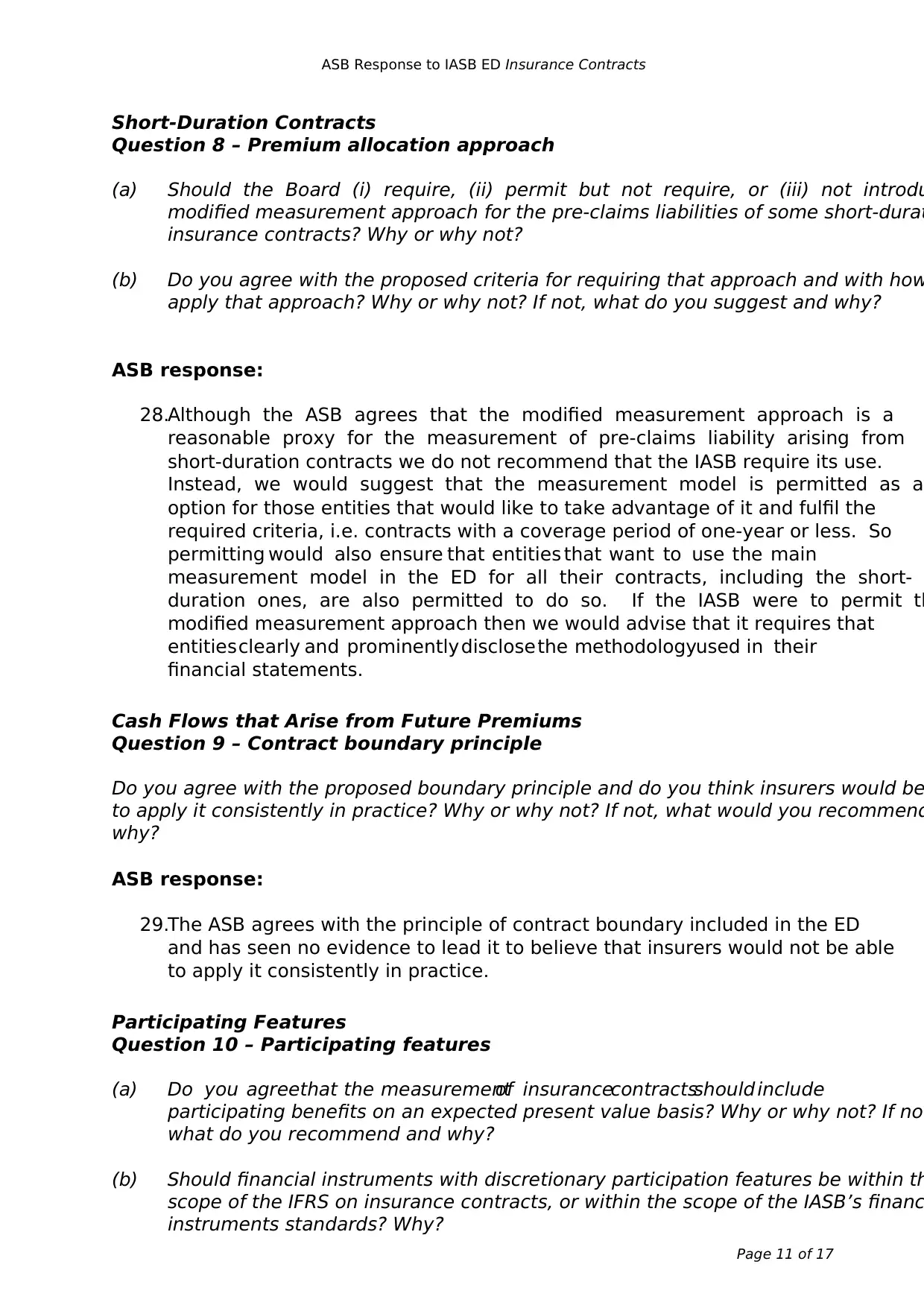
ASB Response to IASB ED Insurance Contracts
Page 11 of 17
Short-Duration Contracts
Question 8 – Premium allocation approach
(a) Should the Board (i) require, (ii) permit but not require, or (iii) not introdu
modified measurement approach for the pre-claims liabilities of some short-durat
insurance contracts? Why or why not?
(b) Do you agree with the proposed criteria for requiring that approach and with how
apply that approach? Why or why not? If not, what do you suggest and why?
ASB response:
28.Although the ASB agrees that the modified measurement approach is a
reasonable proxy for the measurement of pre-claims liability arising from
short-duration contracts we do not recommend that the IASB require its use.
Instead, we would suggest that the measurement model is permitted as an
option for those entities that would like to take advantage of it and fulfil the
required criteria, i.e. contracts with a coverage period of one-year or less. So
permitting would also ensure that entities that want to use the main
measurement model in the ED for all their contracts, including the short-
duration ones, are also permitted to do so. If the IASB were to permit th
modified measurement approach then we would advise that it requires that
entities clearly and prominently disclose the methodologyused in their
financial statements.
Cash Flows that Arise from Future Premiums
Question 9 – Contract boundary principle
Do you agree with the proposed boundary principle and do you think insurers would be
to apply it consistently in practice? Why or why not? If not, what would you recommend
why?
ASB response:
29.The ASB agrees with the principle of contract boundary included in the ED
and has seen no evidence to lead it to believe that insurers would not be able
to apply it consistently in practice.
Participating Features
Question 10 – Participating features
(a) Do you agreethat the measurementof insurancecontractsshould include
participating benefits on an expected present value basis? Why or why not? If not
what do you recommend and why?
(b) Should financial instruments with discretionary participation features be within th
scope of the IFRS on insurance contracts, or within the scope of the IASB’s financ
instruments standards? Why?
Page 11 of 17
Short-Duration Contracts
Question 8 – Premium allocation approach
(a) Should the Board (i) require, (ii) permit but not require, or (iii) not introdu
modified measurement approach for the pre-claims liabilities of some short-durat
insurance contracts? Why or why not?
(b) Do you agree with the proposed criteria for requiring that approach and with how
apply that approach? Why or why not? If not, what do you suggest and why?
ASB response:
28.Although the ASB agrees that the modified measurement approach is a
reasonable proxy for the measurement of pre-claims liability arising from
short-duration contracts we do not recommend that the IASB require its use.
Instead, we would suggest that the measurement model is permitted as an
option for those entities that would like to take advantage of it and fulfil the
required criteria, i.e. contracts with a coverage period of one-year or less. So
permitting would also ensure that entities that want to use the main
measurement model in the ED for all their contracts, including the short-
duration ones, are also permitted to do so. If the IASB were to permit th
modified measurement approach then we would advise that it requires that
entities clearly and prominently disclose the methodologyused in their
financial statements.
Cash Flows that Arise from Future Premiums
Question 9 – Contract boundary principle
Do you agree with the proposed boundary principle and do you think insurers would be
to apply it consistently in practice? Why or why not? If not, what would you recommend
why?
ASB response:
29.The ASB agrees with the principle of contract boundary included in the ED
and has seen no evidence to lead it to believe that insurers would not be able
to apply it consistently in practice.
Participating Features
Question 10 – Participating features
(a) Do you agreethat the measurementof insurancecontractsshould include
participating benefits on an expected present value basis? Why or why not? If not
what do you recommend and why?
(b) Should financial instruments with discretionary participation features be within th
scope of the IFRS on insurance contracts, or within the scope of the IASB’s financ
instruments standards? Why?
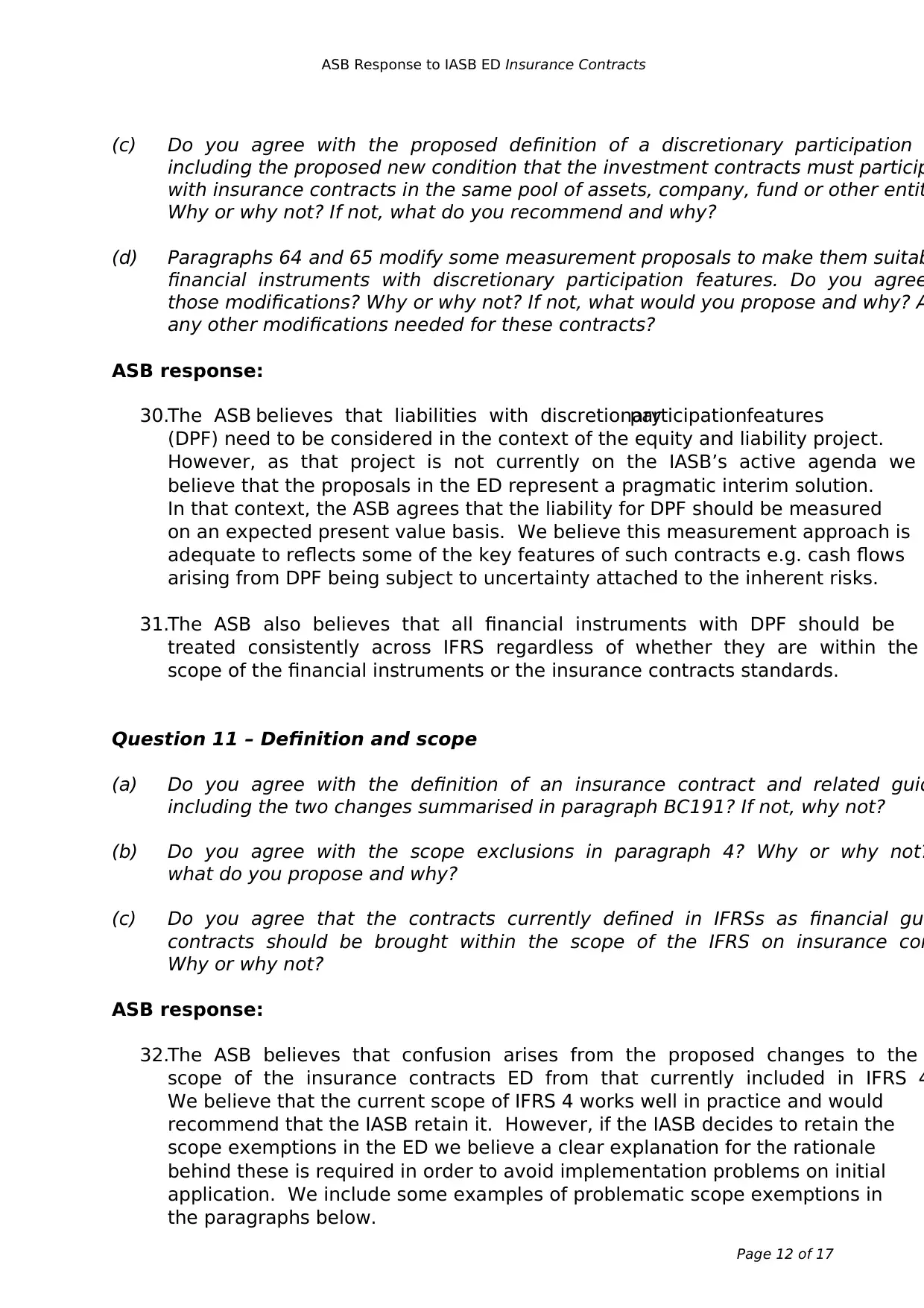
ASB Response to IASB ED Insurance Contracts
Page 12 of 17
(c) Do you agree with the proposed definition of a discretionary participation
including the proposed new condition that the investment contracts must particip
with insurance contracts in the same pool of assets, company, fund or other entit
Why or why not? If not, what do you recommend and why?
(d) Paragraphs 64 and 65 modify some measurement proposals to make them suitab
financial instruments with discretionary participation features. Do you agree
those modifications? Why or why not? If not, what would you propose and why? A
any other modifications needed for these contracts?
ASB response:
30.The ASB believes that liabilities with discretionaryparticipationfeatures
(DPF) need to be considered in the context of the equity and liability project.
However, as that project is not currently on the IASB’s active agenda we
believe that the proposals in the ED represent a pragmatic interim solution.
In that context, the ASB agrees that the liability for DPF should be measured
on an expected present value basis. We believe this measurement approach is
adequate to reflects some of the key features of such contracts e.g. cash flows
arising from DPF being subject to uncertainty attached to the inherent risks.
31.The ASB also believes that all financial instruments with DPF should be
treated consistently across IFRS regardless of whether they are within the
scope of the financial instruments or the insurance contracts standards.
Question 11 – Definition and scope
(a) Do you agree with the definition of an insurance contract and related guid
including the two changes summarised in paragraph BC191? If not, why not?
(b) Do you agree with the scope exclusions in paragraph 4? Why or why not?
what do you propose and why?
(c) Do you agree that the contracts currently defined in IFRSs as financial gua
contracts should be brought within the scope of the IFRS on insurance con
Why or why not?
ASB response:
32.The ASB believes that confusion arises from the proposed changes to the
scope of the insurance contracts ED from that currently included in IFRS 4
We believe that the current scope of IFRS 4 works well in practice and would
recommend that the IASB retain it. However, if the IASB decides to retain the
scope exemptions in the ED we believe a clear explanation for the rationale
behind these is required in order to avoid implementation problems on initial
application. We include some examples of problematic scope exemptions in
the paragraphs below.
Page 12 of 17
(c) Do you agree with the proposed definition of a discretionary participation
including the proposed new condition that the investment contracts must particip
with insurance contracts in the same pool of assets, company, fund or other entit
Why or why not? If not, what do you recommend and why?
(d) Paragraphs 64 and 65 modify some measurement proposals to make them suitab
financial instruments with discretionary participation features. Do you agree
those modifications? Why or why not? If not, what would you propose and why? A
any other modifications needed for these contracts?
ASB response:
30.The ASB believes that liabilities with discretionaryparticipationfeatures
(DPF) need to be considered in the context of the equity and liability project.
However, as that project is not currently on the IASB’s active agenda we
believe that the proposals in the ED represent a pragmatic interim solution.
In that context, the ASB agrees that the liability for DPF should be measured
on an expected present value basis. We believe this measurement approach is
adequate to reflects some of the key features of such contracts e.g. cash flows
arising from DPF being subject to uncertainty attached to the inherent risks.
31.The ASB also believes that all financial instruments with DPF should be
treated consistently across IFRS regardless of whether they are within the
scope of the financial instruments or the insurance contracts standards.
Question 11 – Definition and scope
(a) Do you agree with the definition of an insurance contract and related guid
including the two changes summarised in paragraph BC191? If not, why not?
(b) Do you agree with the scope exclusions in paragraph 4? Why or why not?
what do you propose and why?
(c) Do you agree that the contracts currently defined in IFRSs as financial gua
contracts should be brought within the scope of the IFRS on insurance con
Why or why not?
ASB response:
32.The ASB believes that confusion arises from the proposed changes to the
scope of the insurance contracts ED from that currently included in IFRS 4
We believe that the current scope of IFRS 4 works well in practice and would
recommend that the IASB retain it. However, if the IASB decides to retain the
scope exemptions in the ED we believe a clear explanation for the rationale
behind these is required in order to avoid implementation problems on initial
application. We include some examples of problematic scope exemptions in
the paragraphs below.
⊘ This is a preview!⊘
Do you want full access?
Subscribe today to unlock all pages.

Trusted by 1+ million students worldwide
1 out of 17
Related Documents
Your All-in-One AI-Powered Toolkit for Academic Success.
+13062052269
info@desklib.com
Available 24*7 on WhatsApp / Email
![[object Object]](/_next/static/media/star-bottom.7253800d.svg)
Unlock your academic potential
Copyright © 2020–2025 A2Z Services. All Rights Reserved. Developed and managed by ZUCOL.





